Guest Post by Sammy Mikus
You may have heard pigeon owners discuss ethical breeders. These are pigeon breeders who supposedly have healthy, friendly birds who they care about and only sell to people who will take good care of them. While this sounds good on the surface, the truth is that the majority of pigeon breeders aren’t ethical, and anyone can claim to be an “ethical” breeder without actually being one.
In this post, I’ll go over the need for rescue, whether or not ethical breeders are necessary, the problems with breeding (especially on this scale), and how the majority of pigeon breeders are not “ethical”, even by their own standards and the standards of their customers.
Is Ethical Breeding Necessary?
Pigeons are not wild birds; they’ve been domesticated for an extremely long time. There are plenty of them already in captivity. So is there a need for ethical breeding at all?
Many people argue that ethical breeders provide healthy, tame pigeons in specific breeds that they otherwise wouldn’t be able to get from a rescuer. Let’s go over each of these points.
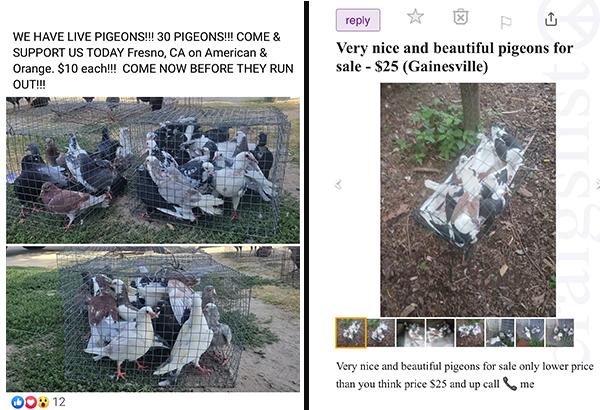
Breeders often cram pigeons together into wire cages when they want to sell/advertise them.
MYTH: There are no tame pigeons in rescue.
FACT: It’s a huge task for rescuers to find homes for imprinted ferals who were rescued after being released by their previous owners, or were raised by the rescuers themselves. Rescuers also end up with many domestic pigeons of various breeds who are tame when rescued or surrendered. (I’ll talk about friendliness and how it relates to breed in a bit.)
MYTH: Most rescuers only adopt out pigeons once they’re healthy.
FACT: If any of their pigeons have a chronic condition or disability, rescuers are usually upfront about it. Plus, many rescuers will continue to lend you support and advice if something happens down the line that compromises your pigeon’s health. While it is true that rescuers often take in pigeons who are sick or injured, they provide medical care and work hard to get these birds back to full health. Meanwhile, a pigeon from a breeder has often never been to a vet, and could have issues that the breeder isn’t aware of. Unfortunately, a lot of people have bought from breeders and ended up with a sick, or even dying, pigeon. I’ll talk about that more a bit later.
Many times, people will buy a young pigeon from a breeder because they want a cuddly bird. However, getting a young pigeon from a breeder is absolutely no guarantee of temperament. Most pigeons have a major behavior change once they hit puberty, and I’ve seen countless stories of people buying birds that their breeders claimed would have a specific personality, just for the pigeon to end up being feistier or more aloof than the new owner was prepared for. (Not that there’s anything wrong with feisty and aloof pigeons — it’s just wrong to claim that breed guarantees a specific temperament.)
Rescuers, unlike most breeders, will generally take back your pigeon if the adoption doesn’t work out for any reason. Plus, many rescuers will be open to a foster arrangement to make sure a pigeon is the right fit for you.
MYTH: I want a specific breed, so I need to go to a breeder.
FACT: The truth is, many, many “fancy” breeds end up escaped, lost, dumped, and surrendered. They wait for homes for months, or even years, at rescues, wildlife rehabs, and animal shelters. Like tame pigeons, there is no shortage of “fancy” breeds in rescue. If you are looking to adopt a specific breed for their looks and can’t find one in need of rescue, please keep an open mind. Breeding for looks almost always results in detrimental traits that the pigeon is left to live with. Inbreeding (used to get a specific look) results in birds with poor health and compromised immune systems. The very traits that make these breeds distinctive are the direct cause of their health issues.
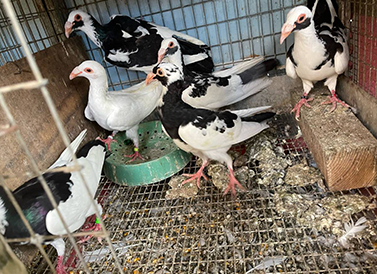
Scandaroons being sold on Craigslist.
What’s the Problem With Breeding?
Most pigeon breeds, especially “fancy”/show breeds, have exaggerated traits that are often appealing to people. However, these traits come with a wide range of issues for the birds, which can vary from inconvenient to harmful.

Left: The German Owl pigeon’s tiny beak makes eating difficult – and as parents, they often struggle to feed their young. Right: The American Fantail at a show. This breed struggles a lot with mobility due to the extreme stance they’re bred to have.
For instance, short beaks (found in Oriental Frills, Old German Owls, Portuguese Tumblers, etc.) make administering oral medication and dewormer difficult, and make preening really tough (which can result in droppings getting stuck near their butt feathers). The short beak also causes them to struggle to pick up large seeds, and increases the chance of small seeds getting stuck in their nostrils due to how close their nostrils are to the tip of their beak. (You may have seen the chart with “ethical” and “non-ethical” pigeon beak lengths. The truth is, this chart is inaccurate — and an example of breeds claimed by breeders to be “ethical” that aren’t. The beaks listed as “medium” are short, and the Lucerne breed is listed as having a “normal” beak despite also being short-beaked.)
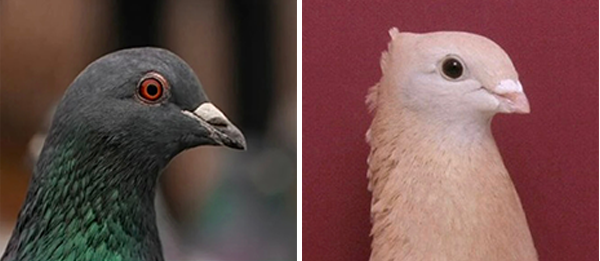
Normal length feral pigeon beak (left) vs. short Lucerne breed beak. Short beaks cause a variety of problems for many pigeon breeds.
Large breeds (Modenas, Giant Runts, etc.) are much more likely to get arthritis and often struggle with heart issues due to their size. These breeds often have lessened mobility as well.
Feathered feet (Indian Fantails, West of England Tumblers, etc.) decrease mobility and greatly increase the risk of broken blood feathers on the feet and legs. The long feathered feet seen in many breeds are actually wing feathers, so can be uncomfortable, and even painful, especially when they’re growing in after a molt.
Large eyes (Budapest Tumblers, Vienna Tumblers, etc.) are at an increased risk of eye ulcers and irritation.
Pouter and Cropper breeds are prone to crop issues (such as sour crop and impacted crop) — their crops can get stuck in the inflated position and they may even need crop reduction surgery to have a good quality of life.
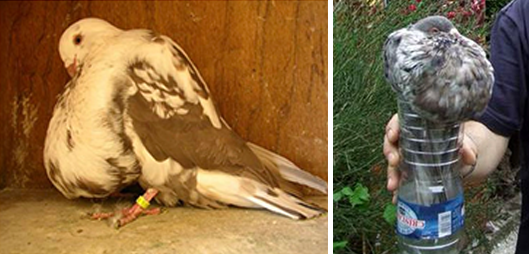
Left: Pouters and croppers frequently experience crop problems.[1] Right: An example of a crude DIY treatment for an impacted crop – fanciers often treat health problems themselves rather than simply avoiding buying and breeding birds that have such harmful traits.[2]
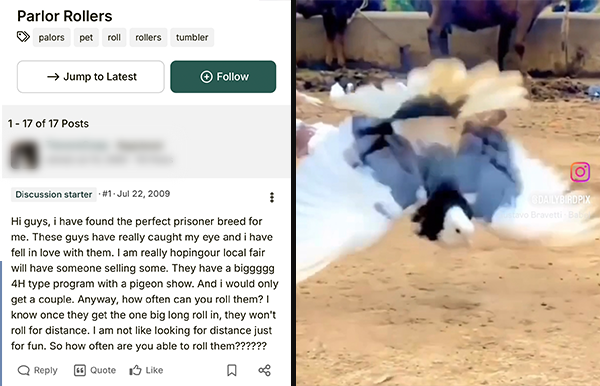
Left: Parlor Rollers described as a “prisoner” breed due to being unable to fly.[3] Right: This breed is even used in competitions where people see how far they can “roll” them, like a bowling ball (screenshot from Instagram account showing a Parlor Roller at an event).
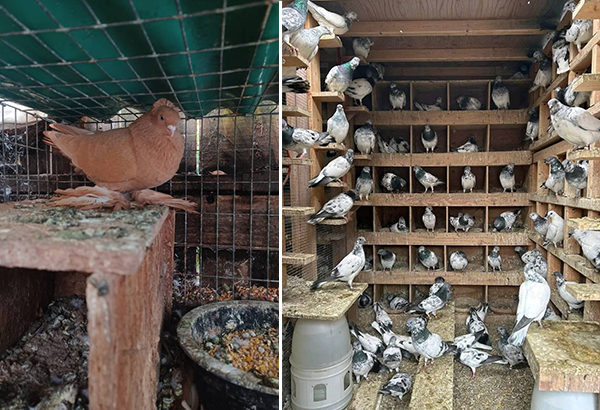
The stress of overcrowding increases aggression, causing adults to get bullied and young pigeons to get injured and killed. Overcrowding also results in a lowered immune system, putting pigeons at greater risk of disease.
Unfortunately, even ethical breeders have been found to have overcrowded, dirty, and/or non-predator-proof lofts. While this certainly isn’t true of all breeders, the majority of those who let their pigeons breed in an aviary/loft environment face issues with overcrowding and the unhygienic and stressful conditions that follow. This can lead to an increase in disease and bullying. Overcrowding also results in greatly increased squab mortality; baby pigeons and developed eggs are killed in the nest by competitors and bullied after they leave the nest, which often ends fatally for young birds who are still getting the hang of flying.
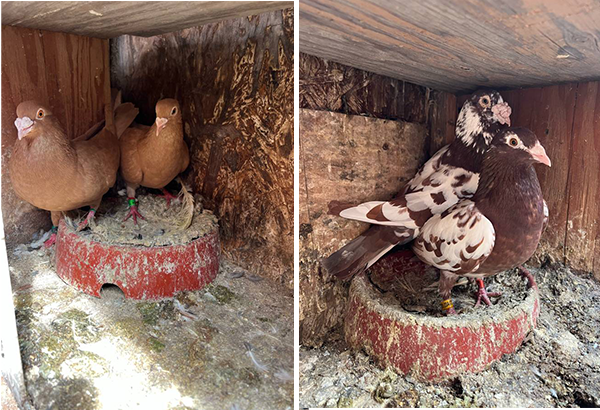
Filthy living conditions are not uncommon in breeding lofts.[4]
Also, to make specific pairings in a multi-breed loft, already existing mated pairs are broken up and the new pairs are kept in smaller, often wire cages to produce the desired mating.
What If I Want to Buy a Bird From a Breeder to Give Them a Better Life?
Buying a bird from a breeder would be supporting and enabling them — both in loft space and funding — to breed more birds. Also, adopting a rescue pigeon not only provides them with a good home, it also helps a rescuer, supporting their effort to save the lives of birds who are in danger. (Note: Breeders may advertise their excess birds as “culls”, but this doesn’t necessarily mean the pigeons will be killed if not rescued.)
There is a great need for pigeon rescue. There is no need for more breeders. Breeders are losing and discarding pigeons faster than rescuers can find adopters. People who can’t keep their breeder-bought pigeons end up turning to overfull rescuers for help. Lost domestic pigeons are being euthanized in shelters and left outside when their finders have nowhere to take them. (And that’s not to mention all the disabled ferals who are left in the wild with nowhere to go, and all the disabled and imprinted ferals who are euthanized in wildlife rehabs due to being unreleasable.)
In conclusion, please consider adopting a pigeon in need rather than buying from a breeder. If you don’t know where to find a rescue, the Palomacy Facebook Help Group can probably help if you share your location and the setup you have for your future pet!
Please don’t breed your pigeons. If you want more there are plenty in need of homes! Pigeons don’t need to breed to be happy.
Sources
1,2: “Crop Problems at Our Pigeons”. Aviculture Europe, 2007. Accessed 10/04/25.
3. Pigeons.Biz User post, 07/22/09. Accessed 10/05/25.
4. Pictures from Craigslist ads selling pigeons.
